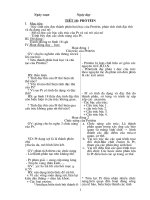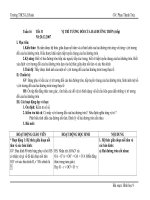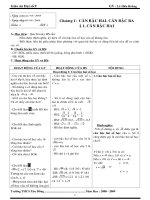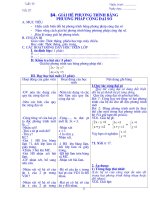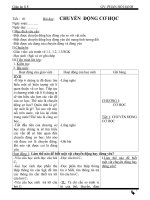Giao an English 9 Unit 2
Bạn đang xem bản rút gọn của tài liệu. Xem và tải ngay bản đầy đủ của tài liệu tại đây (91.71 KB, 12 trang )
<span class='text_page_counter'>(1)</span><div class='page_container' data-page=1>
Date of plan: 9/ 9/ 2009
Date of teaching:
Week: 4
7th<sub> period </sub>
Unit 2 - clothing
<b>Lesson 1 - getting started & listen and read</b>
A. Objectives: By the end of the lesson, students will be able to understand
the content of the text and speak something about the text.
B. Content: Vocabularies: poem, tunic, ethnic minority, an inspiration,
unique.
Grammar: The present perfect tense with “since, for”
(+) S + have/ has + PII
(-) S +haven’t/hasn’t +PII
(?) Have/ Has/Haven’t/Hasn’t +S +PII
C. Materials: pictures, cassette, books.
D. Anticipated problems: SS may get difficulties in remembering some new
words like <i><b>ethnic, minority, inspiration, unique</b></i>.
E. Procedure:
Teacher Students
I. Warmer: Getting started- “Kim’s game”.
- give 6 pictures and ask Ss to look at the pictures
discuss then answer the question:
Where does he (she) come from?
II. Presentation:
<b>1. pre- teach vocabulary</b>:
a poem (n):
a tunic (n):
slit(v):
ethnic minority(n):
an inspiration(n):
unique (adj):
bài thơ- expl
quần áo rộng và chùng- expl
xẻ - expl
dân tộc thiểu số- trans
sự hứng khởi- trans
độc đáo - expl
- have Ss copy
* check vocabulary: Matching
<b>2. Presentation:</b>
- set the scene: the text is about the Ao dai of
Vietnam. Now listen to the text about it.
- Turn on the tape 2 times.
- Ask Ss to read the text loudly.
<b>3. Model sentences.</b>
Some have printed ...fashionable.
- explain: the present perfect tense is used to :
+ express an action without time.
+ express an action; started in the past, happening
at the present and continue in the future( since +
mèc thêi gian, for + kho¶ng thêi gian)
+ Form:
(+) S + have/ has + PII
(-) S +haven’t/hasn’t +PII
(?) Have/ Has/Haven’t/Hasn’t +S +PII
- answer
individually:
She/He comes from
Japan/ Vietnam/
Scotland/ India/ the
USA/ Arabia (Arap).
- whole class to
listen, then repeat
- repeat
individually
- Do matching
individual.
</div>
<span class='text_page_counter'>(2)</span><div class='page_container' data-page=2>
III. Practice:
- ask Ss to make sentences with “used to”
- let Ss read the text in silently about 5 minutes,
then do “ multiple choice”
<b>4. Exercise a.</b>
- Ask Ss to do exercise (a) in groups
- call 1 student to talk before class
- give the correct answers
1. ……..poems, novels and songs.
2. ……..along silk tunic slits up the sides worn
over loose pants.
3. …….. to wear modern clothing at work.
4. …….. of poetry on it.
5. ……….symbols such as suns, stars, crosses
and trips.
<b>5. Exercise b.</b>
Answer question:
1. Traditionally, men and women used to wear the
“Ao dai”.
2. Because it is more convenient.
3. They have printed lines of poetry on it or have
added symbols such as suns, stars, and trips to
the “Aodai”.
IV. Production:
<b>6. Discussion: </b>
- ask Ss to discuss about the text
- go around and help Ss
- ask 1 S to speak before class
VI. Home work.
Ask Ss to:
- Read the text at home again.
- Talk about the content of the text (5-10
sentences).
- Do exercises 1,2
- Prepare lesson 2: Speaking
- Work individual.
- work in pairs
- whole class to
copy
- work individual
- group work
- copy homework
Date of plan:
Date of teaching:
Week: 5
8th<sub> period </sub>
<b>Lesson - Speak & test 15’</b>
A. Objectives: By the end of the lesson, Ss will be able to practice
interviewing and reporting in groups.
B. Content: Vocabularies about clothes: colorful T- shirt, plaid skirt, short
sleeved blouse, sleeveless sweater, striped shirt, baggy pants, faded jeans,
blue shorts.
Grammar: reported speech: “….said (that) + clause”
C. Materials: books, pictures, some modes of clothes on the book.
D. Anticipated problems: Some weak students can’t speak any English
words.
E. Procedure:
</div>
<span class='text_page_counter'>(3)</span><div class='page_container' data-page=3>
I. Warm- up: “Noughts and crosses”
traditional special convenient
poets designers pants
wear use take
II. Pre- speaking.
1.pre-teach vocabulary:
colorful T- shirt(n):
plaid skirt(n):
short sleeved blouse(n):
sleeveless sweater(n):
striped shirt(n):
baggy pants(n):
faded jeans(n):
blue shorts(n):
áo phông nhiều màu- trans
váy kẻ ô - picture
áo sơ mi cộc tay expl
áo len cộc tay realia
áo kẻ trans
quần thụng trans
quần bò mài - realia
quần soóc xanh trans
*Check: Matching( a- p.14)
2. set the scene: (b- p.14)
- ask Ss to work in small groups to write two more
questions for the last section of this survey about
clothes Ss wear.
- ask 1 S in each group to say
- give suggestions:
1. What type of clothing do you wear on Tet (Lunar
New Year)?
2. What would you wear to a party?
- ask Ss to interview members of another group with
the questions:
“What do you usually wear on the weekend?
Why do you wear these clothes?
What is your favorite type of clothing? Why?
Is it comfortable? What color is it? (+ questions 1 & 2)
III. While- speaking.
- ask 1 S to report the result of the interview
- give examples:
“Huong said she liked to wear faded jeans on the
weekend because she felt very comfortable.”
“Tuan said that a colorful T- shirt was his favorite type
of clothing.”
“People said that the blue uniform of their school was
very beautiful and comfortable.”
IV. Post- speaking: “ Write it up”
- ask Ss to work in groups and write about the
advantages and disadvantages of uniform.
V. Homework:
- Ask Ss to do exercises in the exercises book and
prepare lesson 3 “ listening”
VI. Test 15’:
- work in groups
- whole class
- individual
- whole class to
copy
- individual
- group work
- individual
- work individually
- work in groups
- whole class
</div>
<span class='text_page_counter'>(4)</span><div class='page_container' data-page=4>
Date of plan:
Date of teaching:
Week: 5
9th<sub> period </sub>
<b>LESSON 3 - listen</b>
A. Objectives: By the end of the lesson, Ss will be able to practice the skill of
listening and choose the correct pictures in the tape.
C. Content: listening about a public announcement.
B. Materials: books, pictures, a cassette, chalk.
D. Anticipated problems: some weak Ss can’t hear any words.
E. Procedure:
Teacher<b> Students</b>
I. Revision: “ Net works ”
skirt shock
suit
jeans <b> uniform</b>
T- shirt casual
shirt
II. Pre- listening:
1. Set the scene: “in this lesson, you hear a
public announcement about a lost little girl
called Mary. First you name the clothes in the
picture.
- run through some new words: floral - hoa ,
polka dot: chÊm 2 tÇng
- ask Ss to name the picture individually.
- give the correct answers:
a. A- floral pants, B- blue shorts, C- polka dot
skirt
b. A- long sleeved white blouse, B- short sleeved
pink shirt, C- short sleeved white shirt
c. A- sandals, B- boots, shoes with flowers
- ask Ss to read the words 1 time after the
- individual
- whole class
- whole class
- individual
- whole class to
copy the answers
- whole class
</div>
<span class='text_page_counter'>(5)</span><div class='page_container' data-page=5>
teacher
III. While- listening:
- ask Ss to listen to the tape and check the letter
of the correct picture to show what Mary is
wearing.(2 times)
- ask Ss to compare with the partner.
- ask Ss to give the answers.
- correct Ss’ answers.
Answer key:
a. B - She is wearing blue shorts.
b. A - She is wearing a long sleeved blouse.
c. C - She is wearing brown shoes
IV. Post- listening:
- ask Ss to play a game: “Who is he/ she?”
- hang the pictures on the board
- ask Ss to work in groups to describe the
persons in the picture.
- correct and give marks.
V. Homework:
-ask Ss to do exercises in the exercises book and
prepare the lesson 4- Read
- whole class to listen
to the tape
- pair work
- individual
- whole class to
copy the answers
- group work
- whole class to copy
Date of plan:
Date of teaching:
Week:
10th<sub> period </sub>
</div>
<span class='text_page_counter'>(6)</span><div class='page_container' data-page=6>
A. Objectives: By the end of the lesson, Ss will be able to practice the skill of
“reading and comprehension” and do exercise “filling the information”.
B. Content: Vocabularies: material, style, embroider, picture, out of fashion,
generation.
Grammar: “….to be made of…..”
C. Materials: books, a poster.
D. Anticipated problems: some weak Ss can’t understand the content of the
test.
E. Procedure:
Teacher<b> Students</b>
I. Revision: “Brainstorming” “ Jeans”
- give the instructions.
- correct answers:
+ easy to wear
+ convenient
+ fashionable
+ durable- bÒn
II. Pre- reading:
1. Pre-teach vocabulary:
material(n): chÊt liệu - expl
style (n): kiểu cách - expl
embroider(v): thêu - expl
label(n): nh·n m¸c - picture
out of fashion (adj): lỗi thời trans
generation(n): thế hệ trans
* Check: matching.
2. Set the scene: “Today we’re reading about
jeans, the history of jeans”.
3. Model sentences in the text:
+ To be made from…..: lµm b»ng
Example: Jean was made from cotton.
+ To wear wore( past simple)
+ 1960s: nh÷ng năm 60
- let Ss read the text silently in 5 minutes
III. While- reading:
4. Filling information.
- ask Ss to do exercise in (a)
- ask Ss to compare with partner
- ask Ss to give the answers before class
- give the correct answers:
1. 18th<sub> century</sub>………<sub>jean cloth</sub>……
2. 1960s………students…….
3. 1970s……….cheaper…….
4. 1980…………fashion……..
5. 1990s………..sale………..
- ask Ss to read the text again in silent.
5. Comprehension questions
- ask Ss to work in pairs
- whole class, then
individual
- whole class
- individual
- whole class
- whole class to listen
- whole class to copy
- individual
- pair work
- individual
- whole class to copy
</div>
<span class='text_page_counter'>(7)</span><div class='page_container' data-page=7>
- suggest
- give the correct answers:
1. The word “jeans” comes from a kind of
material that was made in Europe.
2. The 1960s’ fashions were embroidered jeans,
painted jeans and so on.
3. Because jeans became cheaper.
4. Jeans at last became high fashion clothing in
the 1980s.
5. The sale of jeans stopped growing because
word – wide economic situation got worse in
the 1990s.
IV. Post- reading:
6. T/F repetition drill.
- give the instructions.
1. The word “jeans” comes from a kind of
material that was made in Asia.
2. Mary students wore jeans in the 1960s.
3. Jeans at last became low fashion clothing in
the 1980s.
4. Te sale of jeans stopped growing in the
1990s.
V. Homework:
-ask Ss to do exercises 2,3,4 in the exercises
book and prepare the lesson 5 -write
- whole class to copy
- teacher - whole class
- whole class
Date of plan:
Date of teaching:
Week:
11th<sub> period </sub>
<b>Lesson 4 - write</b>
A. Objectives: By the end of the lesson, Ss will be able to write an
argumentative writing.
B. Content: The simple present tense.
C. Materials: books, a picture, posters.
D. Anticipated problems: Some weak students can’t understand and
complete their writing, so most of the time they are free.
E. Procedure:
Teacher Students
I. Warm-up: “Brainstorming” “Wearing casual
clothes in school”
- give suggestions:
+ nice
+ comfortable
+ freedom of choice
+ make school colorful and lively
- whole class
- individual
</div>
<span class='text_page_counter'>(8)</span><div class='page_container' data-page=8>
+ self confident
II. Pre- writing:
1. Presentation:
- say: if you want to write an argument, you have to
carry out 3 parts:
+ part 1: Introduction Let the reader know the
writer’s point of view, using language (My opinion
is……/ I think…….)
+ part 2: Present arguments Presents arguments
in a logical way (one in each paragraph), give
example where possible, using language (firstly…./
Secondly…/ Finally….)
+ part 3: Conclusion sum up the argument, using
language (Therefore…/ In conclusion…).
- present: This is an argument that support the idea
that secondary student should wear uniforms
- ask Ss to read part (a) in groups to understand
III. While- writing.
- ask Ss to base on (a)-form, using “out line B” and
write an argument about supporting that secondary
school should wear casual clothes.
- give suggestions:
feel comfortable: cảm thấy thoải mái
freedom of choice: tự do lùa chän
- go around class and help them
- correct some Ss’ writings
- give the correct writing:
“In my opinion, secondary school students
should wear casual clothes.
Firstly, wearing casual clothes gives students
freedom of choice. They have rights to choose sizes,
colors and fashions that they have love.
Thirdly, casual clothes make students feel self
– confident when they are in their favorite clothes.
Finally, casual clothes make school more
colorful and lively.
In conclusion, secondary school students should
wear casual clothes. Wearing casual clothes is
convenient, comfortable and fun”.
IV. Post-writing: “ classification”
- give the poster with the words: “Equal,
comfortable, self-confident, proud, practical,
colorful, uniform, casual clothes, lively, freedom of
choice.
<b> against</b> <b>support for to </b>
<b>wearing uniform</b>
Comfortable,
self-confident, practical,
colorful, casual clothes,
lively, freedom of choice.
equal, proud,
uniform
- whole class to
listen, then copy into
notebooks
- group works
- group works
- teacher- whole
class
- whole class
</div>
<span class='text_page_counter'>(9)</span><div class='page_container' data-page=9>
V. Homework:
- ask Ss to do exercises in the exercises book and
prepare the lesson 5- Language focus 1 - whole class to copy
Date of plan:
Date of teaching:
Week:
12th<sub> period </sub>
<b>Lesson 6 - language focus</b>
A. Objectives and content: By the end of the lesson, Ss will be able to:
- review the present perfect tense with “since, for, yet, already”
- review the passive voice in the present simple tense and “must, can,
should, may, might…”
- Practice to do some exercises: building a new dialogue, rewriting a
passive from an active form.
B. Materials: books, a picture, posters.
C. Anticipated problems: Some weak students can’t understand the
grammars.
D. Procedure:
Teacher<b> Students</b>
I. Revision: “Classification”
- give the poster with the words: “ last month,
three days, 2004, yesterday, Monday, ten years,
3 hours, 15 minutes, Saturday, last year”.
- ask Ss to work in groups or individual
- give the answers:
+ since: last month, 2004, yesterday, Monday,
Saturday, last year
+ for: 3 days, 10 years, 3 hours, 15 minutes
II. Present perfect tense
- ask: When do we use the present perfect
tense?
- suggest: + an action began in the past, go on
at the present, will go on in the future.
+ form:
(+) S + have/ has + PII
(-) S + haven’t/hasn’t + PII
(?) Haven’t/ Hasn’t/ Have/ Has + S + PII?
- ask Ss to read the model dialogue (P.19) and
do the same.
- give suggestions and corrects.
a)
A: Lien, come here and see my photo album.
B: Oh, so beautiful! Who’s this boy?
A: It’s Quang, my brother’s friend.
- answer individual
- answer individually
- whole class to listen
</div>
<span class='text_page_counter'>(10)</span><div class='page_container' data-page=10>
B: How long have you known him?
A: I’ve known him for seven months.
B: Have you seen him recently?
A: No, I haven’t seen him since January.
- ask Ss to practice with his/ her partner in b, c
III. The present perfect tense with “already”
and “ yet”
- ask: What is the present perfect tense used
with, besides “since and for”?
- give the answer and explain:
Meaning: The present perfect tense yet= cha,
already=đã, rồi. But the time is not clearly
Form: Have/ Has + (already) + PII + (yet)?
Notes: “yet” is used in the interrogative and
positive.
IV. The present perfect tense with “ever”
- ask: what else is the present perfect tense used
with?
- give the answer and explain:
Meaning: ever=đã từng
Form: Have/ Has +S + ever + PII?
Use: “ever” is used in interrogative form
- ask Ss to practice exercise 3
V. Passive voice
1. Passive voice with the simple present tense
- ask Ss to give the structure
- explain and give example:
They sell jeans all over the word.
S V O
Jeans are sold by them all over the world.
S be +PII by + O
- explain: some subjects: people, they,
someone, somebody, everybody, nobody, are
not used in the passive voice (no need “by +
O”)
- ask Ss to do exercise 4 (p. 21)
- give the suggestions
2. Passive voice with “must, can, may, might,
should”
- ask Ss to give the structure and correct:
S + “must/ can/ may/ might/ should/ be going
to/ will + be + PII + (by+ O)
- give an example:
I must do home work before going to class.
Homework must be done by me….
* Exercise 5.
- ask Ss to do exercise 5 individually
- give the correct answers
a. The problem can be solved by us.
b. Experiments on animals should be stopped.
c. All the schools in the city have to improve by
us.
- individual
- work individually
- whole class to listen
copy
- individually
- whole class to listen
- whole class to
listen, then do
- individually
- individually
- whole class to copy
</div>
<span class='text_page_counter'>(11)</span><div class='page_container' data-page=11>
d. Life on another planet might be found by us.
e. A new bridge is going to be built in the area.
VI. Homework.
- ask s to considerate the knowledge in unit 1
and 2 for the first test 45'.
- whole class to copy
- whole class to copy
Date of plan:
Date of teaching:
Week:
14th<sub> period </sub>
<b>The first test 45’</b>
<b>A. Objectives: by the end of the lesson, Ss will be able to check their </b>
understanding the grammar and vocabularies in unit 1, 2.
<b>B. Content: Vocabularies and Grammars in unit 1, 2</b>
<b>C. Materials: pens, papers</b>
<b>D. Anticipated problems: Some Ss copy their friends’ work</b>
<b>E. Procedure:</b>
I. Ma trËn
<b>Chủ đề</b> <b>Nhận biết</b> <b>Thông hiểu</b> <b>Vận dụng</b> <b>Tổng</b>
KQ TL KQ TL KQ TL
I. Language
<b> focus </b> 15s3m <b>15s</b> <b>3m</b>
II. Reading 10s 2.5m <b>10s</b> <b>3m</b>
</div>
<span class='text_page_counter'>(12)</span><div class='page_container' data-page=12>
III. Listening 2m <b>2m</b>
IV. Writing 6s 2m <b>6s</b> <b>2m</b>
<b>Tæng</b> <b>20s</b>
</div>
<!--links-->


